
Oil Based Emulsifier | Primary And Secondary Emulsifiers
Oil Based Emulsifier include primary and secondary emulsifiers. Oil Based Emulsifier is a primary emulsifier for oil – based drilling fluid systems. Oil Based Emulsifier is a yellow-rated emulsifier.
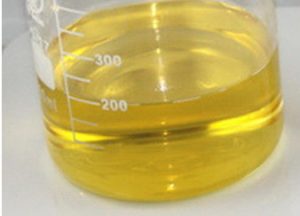
Oil Based Emulsifier can be used worldwide in a number of different drilling fluids.
primary and secondary emulsifiers can be used to prepare to invert emulsion fluids with a variety of weighting agents and are particularly beneficial with manganese tetraoxide.
primary and secondary emulsifiers can also be used effectively in heavy systems at high temperatures to give lower viscosity than traditional emulsifiers.
Advantages
» Primary And Secondary Emulsifiers are speical for North Sea usage
» Imparts reduced viscosity to high-density systems relative to conventional
emulsifiers
Applications/Functions
primary and secondary emulsifiers : effectively disperses high-density particles in emulsions to alleviate settling
Oil Based Emulsifier using calcium chloride or calcium bromide brine
Improves the dispersion of particles in high-density oil drilling fluids
Remains stable at temperatures up to 200°C
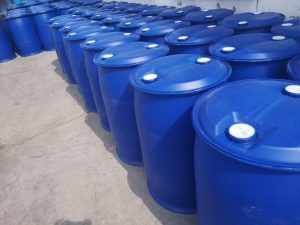
Typical Properties
| Appearance: | Yellow to brown liquid |
| Solubility: | Oil Soluble |
| Flash Point: | > 100°C |
| Specific Gravity: | > 1.0 |
Packaging
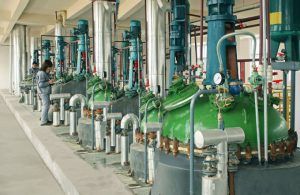
Oil Based Emulsifier | Primary And Secondary Emulsifiers is available in 180L/drums, 14MT/.20FCL.
Primary And Secondary Emulsifiers
CPMUL-P Primary Emulsifier for Oil-Base Mud
CPMUL-P serves as a primary emulsifier in oil-base mud systems. It is formulated to give good emulsification, improved thermal stability of the invert emulsion, and enhanced high-temperature, high-pressure (HTHP) filtration control.
Through comprehensive tests in a number of oil-base mud formulations with various base oils, mud densities, oil/water ratios, and hot-rolling temperatures, it
proves that at working temperature up to 149oC (300oF), CPMUL-P can maintain high ES
(electrical stability), low HTHP filtrate and desired rheological property.
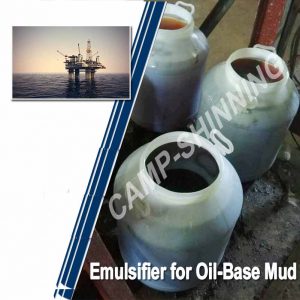
CPMUL-P comprises of modified amidoamine, oxidized fatty acids and low-toxic organic solvent.
We are pleased to offer CPMUL-P with specification as below:
- Phisico-chemical Specification
Appearance: dark mobile liquid
Odor: no or slight odor
Specific Gravity (20℃): 0.93~ 1.03
Flush Point (PMCC): > 65oC (149oF)
Pour Point: < -10oC (14oF)
Solubility: soluble in oil. Insoluble in water.
- Mud Performance Specification
Yield Point (YP): 10 – 20 lb/100ft2
Electrical Stability (ES): minimum 500 Volt
HTHP Filtrate @ 121oC (250oF), 500psi: maximum 12ml
For the test procedure of mud performance, please refer to ANNEX below.
ANNEX
Test Procedure of Mud Performance
- Test Reagents
White oil 5# low-aromatic-content mineral oil, purchased from CNPC
CP-150 high-grade organoclay, made by Camp-Shinning
Calcium hydroxide (lime) analytical grade, from local market
CPmul-S secondary emulsifier, made by Camp-Shinning
Barite API grade, from local market
Rev Dust evaluation clay, from the U.S. market
| 2. Test Mud Formulation | |
| White oil 5# (base oil) | 222ml |
| Organophilic clay CP-150 | 7g |
| Lime | 5g |
| CPmul-P (to be tested) | 6g |
| CPmul-S (Control Sample) | 3g |
| 25% CaCl2 water solution | 60ml |
| API-grade barite | 215g |
| Rev Dust | 15g |
| Mud weight | 11.80ppg |
| O/W ratio | 80:20 |
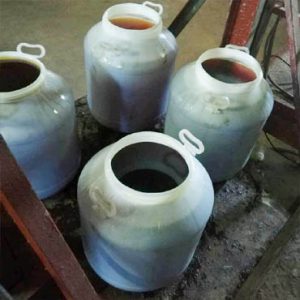
Test Mud Preparation
- 25% CaCl2preparation: Dissolve 25g anhydrous CaCl2 into 75ml distilled water. Store it for service.
- Pour White oil5# into the mixing cup of Hamilton Beach Mixer. While stirring on the mixer at low rpm, add CPmul-P and CPmul-S, and wait until they are fully dissolved in the oil.
- Then at 11000rpm stirring strength, add 25% CaCl2 solution slowly into the oil. Then add other additives at the order of lime, CP-150, Rev Dust and barite. When everything is added, continue to stir the mud at 11000rpm for 30 minutes.
- Mud Performance Test
- Warm the mud to 49oC (120oF). Test R600 (dial reading at 600rpm of Fann 35 VG Meter), R300, R200, R100, R6, R3, 10-seconds gel strength and 10-minutes gel strength. Calculate Yield Point (YP):
YP= 2xR300 – R600 (lb/100ft2)
- Hot roll the test mud in a hot roller at 121oC (250oF) for 16 hours. After hot rolling, cool the mud to 49oC (120oF), then test R600, R300, R200, R100, R6, R3, 10-seconds gel strength and 10-minutes gel strength. Calculate Yield Point (YP):
YP= 2xR300 – R600 (lb/100ft2)
- Electric Stability (ES) is tested always at room temperature. ES is tested before and after hot rolling. Before testing ES, stir the mud at 6000rpm for 10 minutes on Hamilton Beach Mixer.
- HTHP filtrate is tested after hot rolling. Test is at 121oC (250oF) and 500psi pressure differential. Collect the filtrate for 30 minutes.
CPMUL-S Secondary Emulsifier for Oil-Base Mud
CPMUL-S serves as a secondary emulsifier in oil-base mud systems. When combined with primary emulsifier CPmul-P, CPMUL-S can provide good emulsification, improved thermal stability of the invert emulsion, and enhanced high-temperature, high-pressure (HTHP) filtration control.
Through comprehensive tests in a number of oil-base mud formulations with various base oils, mud densities, oil/water ratios and hot-rolling temperatures, it proves that at working temperature up to 149oC (300oF), the combination CPMUL-P/CPMUL-S can maintain high ES (electrical stability), low HTHP filtrate and desired rheological property.
CPMUL-S comprises of modified amidoamine, oxidized fatty acids and low-toxic organic solvent.
We are pleased to offer CPMUL-S with specification as below:
- Phisico-chemical Specification
Appearance: dark mobile liquid
Odor: no or slight odor
Specific Gravity (20℃): 0.93~ 1.03
Flush Point (PMCC): > 65oC (149oF)
Pour Point: < -10oC (14oF)
Solubility: soluble in oil. Insoluble in water.
- Mud Performance Specification
Yield Point (YP): 10 – 20 lb/100ft2
Electrical Stability (ES): minimum 500 Volt
HTHP Filtrate @ 121oC (250oF), 500psi: maximum 12ml
For test procedure of mud performance, please refer to ANNEX below.
ANNEX
Test Procedure of Mud Performance
- Test Reagents
White oil 5# low-aromatic-content mineral oil, purchased from CNPC
CP-150 high-grade organoclay, made by Camp-Shinning
Calcium hydroxide (lime) analytical grade, from local market
CPmul-P Primary emulsifier, made by Camp-Shinning
Barite API grade, from local market
Rev Dust evaluation clay, from the U.S. market
| 2. Test Mud Formulation | |
| White oil 5# (base oil) | 222ml |
| CP-150 | 7g |
| Lime | 5g |
| CPmul-P (to be tested) | 6g |
| CPmul-S (Control Sample) | 3g |
| 25% CaCl2 water solution | 60ml |
| API-grade barite | 215g |
| Rev Dust | 15g |
| Mud weight | 11.80ppg |
| O/W ratio | 80:20 |
Test Mud Preparation
- 25% CaCl2preparation: Dissolve 25g anhydrous CaCl2 into 75ml distilled water. Store it for service.
- Pour White oil5# into the mixing cup of Hamilton Beach Mixer. While stirring on the mixer at low rpm, add CPmul-P and CPmul-S, and wait until they are fully dissolved in the oil. Then at 11000rpm stirring strength, add 25% CaCl2 solution slowly into the oil. Then add other additives at the order of lime, CP-150, Rev Dust and barite. When everything is added, continue to stir the mud at 11000rpm for 30 minutes.
- Mud Performance Test
- Warm the mud to 49oC (120oF). Test R600 (dial reading at 600rpm of Fann 35 VG Meter), R300, R200, R100, R6, R3, 10-seconds gel strength and 10-minutes gel strength. Calculate Yield Point
(YP):
YP= 2xR300 – R600 (lb/100ft2)
- Hot roll the test mud in a hot roller at 121oC (250oF) for 16 hours. After hot rolling, cool the mud to 49oC (120oF), then test R600, R300, R200, R100, R6, R3, 10-seconds gel strength and 10-minutes gel strength. Calculate Yield Point (YP):
YP= 2xR300 – R600 (lb/100ft2)
- Electric Stability (ES) is tested always at room temperature. ES is tested before and after hot rolling. Before testing ES, stir the mud at 6000rpm for 10 minutes on Hamilton Beach Mixer.
- HTHP filtrate is tested after hot rolling. Test is at 121oC (250oF) and 500psi pressure differential. Collect the filtrate for 30 minutes.
- Oil Based Emulsifier | Primary And Secondary Emulsifiers
Pls inquire us now
Whatsapp: +86-13185071071
